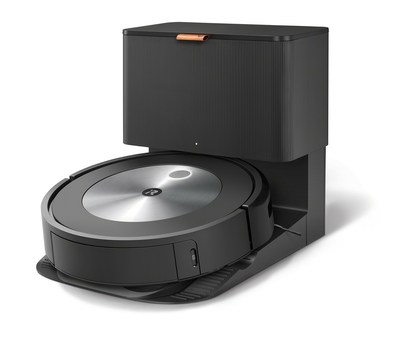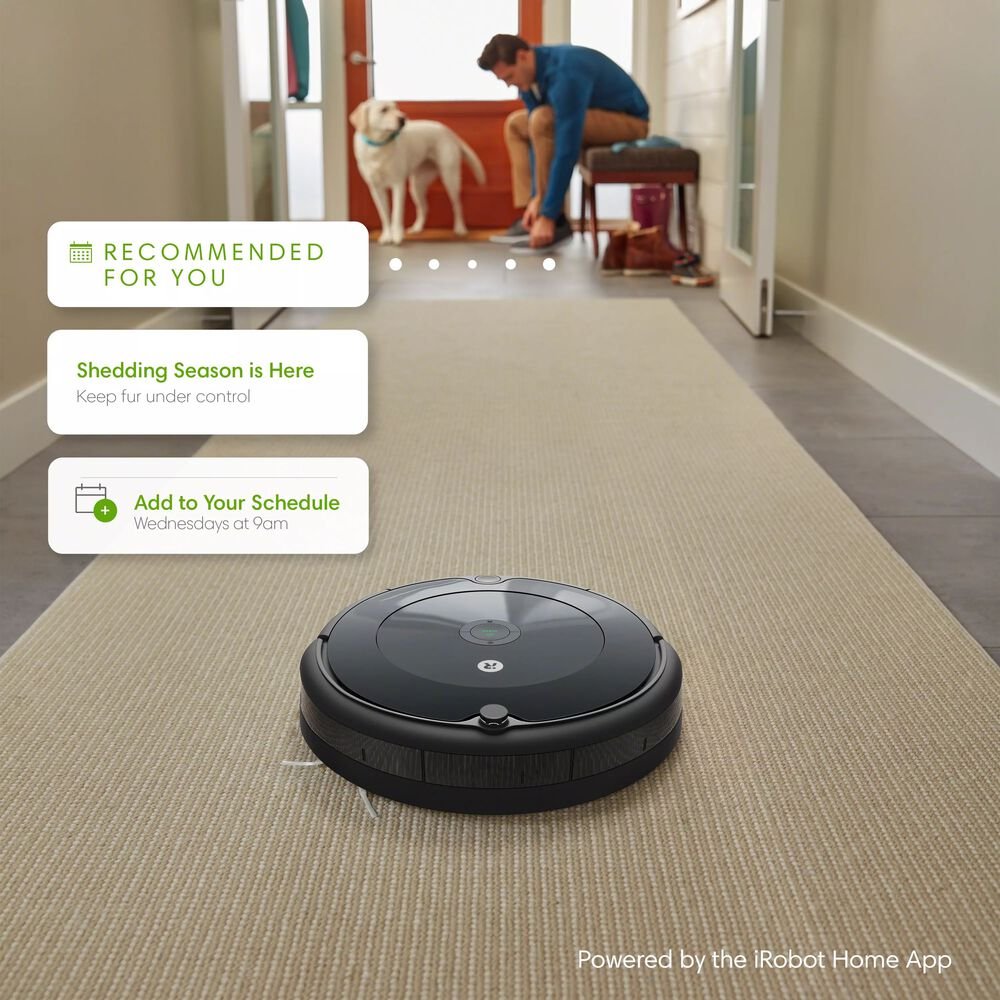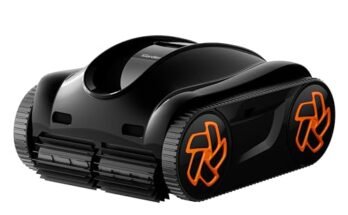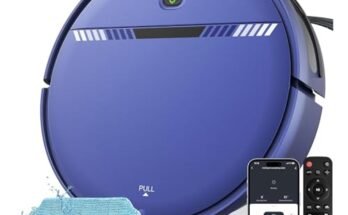Programming a Roomba vacuum cleaner is easier than you might think. You can customize its cleaning schedule to fit your needs.
Roomba vacuum cleaners are smart devices designed to make cleaning effortless. With a few simple steps, you can program your Roomba to clean your home automatically. This guide will walk you through the process, ensuring your Roomba works efficiently. Whether you are tech-savvy or a beginner, programming your Roomba will save you time and keep your floors spotless.
Ready to get started? Let’s dive into the steps to program your Roomba vacuum cleaner and make cleaning a breeze.

Credit: investor.irobot.com
Introduction To Roomba Programming
Welcome to the world of Roomba programming. If you have ever wondered how to control your Roomba vacuum cleaner, you are in the right place. This section will introduce you to the basics of programming a Roomba, helping you get started with ease.
What Is A Roomba?
A Roomba is a robotic vacuum cleaner. It is designed by iRobot and helps keep your home clean with minimal effort. Roombas are small, disc-shaped devices that move around your home, vacuuming dirt and debris from floors.
They are equipped with sensors to navigate around obstacles. They can also return to their charging station when the battery is low. Roombas come in various models, each with unique features and capabilities.
Why Program Your Roomba?
Programming your Roomba allows you to customize its behavior. You can set specific cleaning schedules to suit your needs. This means your home stays clean without manual intervention. Programming can also help your Roomba navigate better in complex spaces.
You can integrate your Roomba with smart home systems. This allows for voice control and remote management. Custom programming can enhance the efficiency and effectiveness of your Roomba, making it a valuable tool for maintaining a clean home.

Credit: www.amazon.com
Necessary Tools And Software
Programming a Roomba vacuum cleaner can be an exciting and rewarding task. To get started, you’ll need some essential tools and software. This section will help you understand the necessary items.
Required Hardware
First, you need a compatible Roomba model. Ensure your model supports programming. A computer is also necessary. It should have USB ports and meet the software requirements. You’ll need a USB cable to connect your Roomba to the computer. Finally, have a screwdriver ready. You’ll need it to access the Roomba’s programming port.
Essential Software
Next, ensure you have the right software. Download the Roomba software development kit (SDK). It is available on the official website. You will also need a programming environment. Popular choices include Python and Arduino IDE. Install the necessary drivers to ensure your computer communicates with the Roomba. Double-check that all software is up to date. This avoids compatibility issues.
Setting Up The Development Environment
Programming a Roomba vacuum cleaner requires setting up a development environment. This process includes installing necessary software and configuring your environment for seamless development. Let’s break down the steps to make it simple and straightforward.
Installing Software
The first step is to install the required software. This software helps you communicate with your Roomba and write code for it.
- Download and install the Arduino IDE. This software is essential for writing and uploading code to your Roomba.
- Ensure you have the correct Roomba library for Arduino. You can find this on GitHub or the Arduino Library Manager.
- Install a serial communication tool like PuTTY or CoolTerm. This helps in debugging and sending commands to your Roomba.
Configuring The Environment
After installing the necessary software, the next step is configuring your environment. This ensures that your tools and Roomba can communicate effectively.
- Connect your Roomba to the computer using a USB-to-serial adapter.
- Open the Arduino IDE and select the correct port and board settings.
- Include the Roomba library in your Arduino sketch. You can do this by going to
Sketch > Include Library > Manage Librariesand searching for “Roomba”. - Use the serial communication tool to test the connection. Set the baud rate to 115200 and check if you can send and receive data.
If you face issues, ensure all drivers are correctly installed. Sometimes, restarting your computer can help resolve connection problems.
By following these steps, you set up a robust development environment for programming your Roomba vacuum cleaner. This setup makes it easier to write, upload, and test your code.

Credit: www.amazon.com
Connecting Roomba To Your Computer
Programming your Roomba vacuum cleaner involves connecting it to your computer. This connection allows you to send commands and updates. There are two main ways to connect your Roomba: wired and wireless. Below, we will explore each method in detail.
Wired Connection
A wired connection is the most straightforward way to connect your Roomba. Follow these steps:
- Ensure you have a USB cable compatible with your Roomba model.
- Turn off your Roomba to prevent any issues during the connection process.
- Connect one end of the USB cable to your Roomba’s data port.
- Attach the other end of the USB cable to your computer’s USB port.
- Turn on your Roomba and wait for your computer to recognize the device.
Your computer should automatically detect the Roomba and install the necessary drivers. If it does not, visit the manufacturer’s website to download and install the drivers manually.
Wireless Connection
Connecting your Roomba wirelessly offers more flexibility. Here’s how to set it up:
- Make sure your Roomba model supports Wi-Fi connectivity.
- Download the Roomba app on your smartphone or computer.
- Open the app and create an account if you don’t have one.
- Follow the in-app instructions to connect your Roomba to your Wi-Fi network.
- Once connected, you can control and program your Roomba through the app.
Ensure your Wi-Fi signal is strong where your Roomba operates. A weak signal can cause connection problems.
Now that your Roomba is connected, you can start programming it to fit your cleaning needs. Whether you prefer a wired or wireless connection, both methods are simple and user-friendly.
Basic Roomba Programming Concepts
Programming a Roomba vacuum cleaner might sound complex, but it is not. You can create custom cleaning schedules and patterns with basic programming knowledge. This section will cover the fundamental concepts you need to get started.
Understanding Roomba Commands
Roomba vacuum cleaners use specific commands to perform tasks. These commands control the movement, cleaning, and other functions of the Roomba. Understanding these commands is crucial for programming your Roomba effectively.
Here are some common commands used in Roomba programming:
- Start: Activates the Roomba to begin cleaning.
- Stop: Halts the cleaning process.
- Dock: Sends the Roomba back to its charging station.
- Spot: Focuses cleaning on a small, specific area.
Each of these commands can be combined to create a custom cleaning routine. For instance, you can program the Roomba to start cleaning at a specific time and return to the dock afterward. Understanding these basic commands is the first step in Roomba programming.
Using The Roomba Api
The Roomba API provides a powerful way to control your vacuum cleaner programmatically. The API allows you to send commands and receive data from your Roomba. Here’s a simple example of how to use the Roomba API:
# Example code to start Roomba using API
import roomba
roomba = roomba.Roomba('your_roomba_ip', 'your_roomba_blid', 'your_roomba_password')
roomba.start()
In this example, you import the Roomba library and connect to your Roomba using its IP address, BLID, and password. Then, you send the start command to begin cleaning. You can expand on this by adding more commands and creating complex routines.
Here are some additional functions you can use with the Roomba API:
| Function | Description |
|---|---|
roomba.stop() |
Stops the Roomba from cleaning. |
roomba.dock() |
Sends the Roomba back to its docking station. |
roomba.spot() |
Starts a spot cleaning session. |
Using the Roomba API opens up endless possibilities for automation and customization. You can integrate Roomba with other smart home devices, create complex cleaning schedules, and more.
Writing Your First Program
Programming a Roomba vacuum cleaner can be fun and rewarding. It lets you control how your Roomba behaves. Let’s dive into writing your first program.
Hello, Roomba!
To start, you need to say “Hello” to your Roomba. This involves writing a simple program. Follow these steps:
- Download the Roomba SDK from the official website.
- Install the SDK on your computer.
- Connect your Roomba to your computer via USB.
- Open your preferred programming environment.
Here’s an example of a basic program:
#include
Roomba roomba;
void setup() {
roomba.begin();
roomba.wakeUp();
}
void loop() {
// Your code here
}
This code initializes your Roomba and wakes it up. Now, your Roomba is ready to receive commands.
Testing The Program
After writing your program, you need to test it. Here’s how:
- Upload your code to the Roomba.
- Observe the Roomba’s behavior.
- If it doesn’t work as expected, check your code for errors.
Testing is crucial. It ensures your program works correctly. Make adjustments as needed and retest.
Advanced Programming Techniques
Programming a Roomba vacuum cleaner can be a rewarding experience. With advanced techniques, you can create custom behaviors and integrate various sensors. This allows your Roomba to perform tasks beyond its factory settings. Let’s explore some advanced programming methods.
Custom Behaviors
Creating custom behaviors for your Roomba can enhance its functionality. You can program it to clean specific areas at certain times. Or, make it avoid obstacles in a unique way. Use the Roomba’s API to write custom scripts. This gives you control over its movements and actions. You can even program it to interact with other smart home devices.
Integrating Sensors
Integrating additional sensors can improve your Roomba’s performance. Sensors can detect dirt, obstacles, or even changes in terrain. You can connect ultrasonic, infrared, or touch sensors. These sensors provide more data to your Roomba. With this data, you can program it to make better decisions. For instance, it can clean more thoroughly or navigate more efficiently.
Troubleshooting Common Issues
Programming a Roomba vacuum cleaner can be fun and rewarding. Yet, there can be some hurdles along the way. Common issues can arise during the process. Don’t worry! These issues are usually easy to fix.
Connection Problems
One common problem is the connection between your device and the Roomba. Make sure both devices are on the same Wi-Fi network. Check if the Wi-Fi signal is strong. Weak signals can cause disconnections.
Ensure the Roomba is in pairing mode. Sometimes, restarting both devices can help. If the problem persists, try resetting the Wi-Fi connection on your Roomba. Refer to the manual for detailed instructions.
Debugging Code
Errors in your code can stop the Roomba from working correctly. Review the code carefully for any mistakes. Look for missing semicolons or brackets. These small errors can cause big problems.
Use a code editor with a debugging feature. This can help you find and fix errors faster. Test the code in small sections. This way, you can easily identify where the problem is.
If you are stuck, online forums can be helpful. Other users may have faced similar issues. They can offer solutions and tips.
Resources For Further Learning
Programming a Roomba vacuum cleaner can seem challenging at first. But with the right resources, you can master it quickly. Here, we have compiled a list of helpful resources to aid your learning journey.
Online Tutorials
There are many online tutorials available for programming your Roomba. These tutorials guide you step-by-step through the process. Some of the popular platforms for finding these tutorials include:
- YouTube: Search for videos by using keywords like “Programming Roomba Tutorial.” Many experts share detailed guides.
- Udemy: This platform offers courses that cover the basics and advanced techniques.
- Coursera: Find courses from top universities that teach you how to code and program your Roomba.
Online tutorials often include visual aids and examples. This makes learning easier and more interactive.
Community Forums
Community forums are an excellent place to get help and share knowledge. Many Roomba enthusiasts are active in these forums. They are always ready to help beginners. Some popular forums include:
- Reddit: The subreddit r/roomba is a great place to ask questions and share experiences.
- Roomba Community: This forum is dedicated to all things Roomba. You can find threads on programming tips and tricks.
- Stack Overflow: This is a broader forum for coding questions. Use it to find answers to specific programming issues.
Forums provide a platform for real-time interaction. You can post your queries and get responses from experienced users.
Frequently Asked Questions
How Do I Start Programming My Roomba?
To start programming your Roomba, you need the iRobot Create 2 Open Interface. This allows you to control and customize its functions.
What Tools Do I Need To Program Roomba?
You need a computer, Roomba, USB cable, and compatible software. The software might include Python or other programming languages.
Can I Use Python To Program My Roomba?
Yes, you can use Python to program your Roomba. Python’s simplicity makes it a great choice for beginners.
Is It Difficult To Program A Roomba?
Programming a Roomba is not very difficult. With basic coding knowledge, you can create simple programs.
Conclusion
Programming a Roomba vacuum cleaner is simpler than it seems. Follow the steps mentioned. Use the app to set schedules and preferences. Ensure your Roomba is charged and ready. Regular updates keep it running smoothly. Experiment with different settings. Clean regularly for optimal performance.
Enjoy a tidy home with minimal effort. Happy cleaning!



